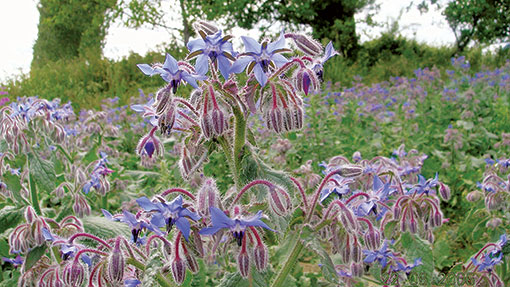Borage area set to rise in 2014

More farmers are needed to start growing one of the most profitable spring crops in 2014. Richard Allison takes a closer look.
Rising demand for the specialist oil produced from borage means the company behind the crop is looking to increase its cropping area by 30% next spring.
Borage is a spring-sown crop grown to produce oil which is high in gamma-linolenic acid, an omega 6 fatty acid, explains Nigel Padbury of Technology Crops.
There is a growing demand for high-grade UK borage oil, for use in dietary supplements, as well as ointments to treat skin disorders such as eczema, rosacea and cradle cap. It is also being developed as a non-dairy creamer.
One reason is that UK-produced oil is recognised as being of higher quality than overseas produced. China is a key producer, but the oil has a GLA content of 17%, lower than the 21-22% in UK oil, he explains.
There are many benefits to farmers growing borage, including blackgrass control and having a crop that is unaffected by slugs and pigeons. But the key attraction is the high gross margin, in excess of £1,000/ha.
Hugh Pegrum has been growing it for six years as an alternative break crop. He farms 586ha near Epping in Essex on London clay and spring cropping is a key part of his rotation to help spread workload.
He grows about 30ha a year, but last year grew 50ha as he had to re-drill some of his oilseed rape which failed because of the wet winter.
“It offers an opportunity to get on top of blackgrass by allowing stale seed-beds in the autumn and then again in the spring.
“In addition, it doesn’t need much storage area being a high value/low volume crop, so we can utilise some old bins which are useful for storing small amounts.”
Another key advantage is slugs. “Nothing will eat it and it is pigeon, slug, deer and rabbit proof,” says Mr Pegrum. “We noticed it last year as we didn’t see as many slugs in the following crop of wheat.
“We also farm on the edge of Epping Forest and we have our fair share of pigeons which graze the oilseed rape.”
Another attraction of the crop is the benefit on bees, says Mr Padbury. Borage does require pollination and if you don’t put bees in the field, it has been known to reduce yields by up to 50%.
“We encourage growers to enlist the help of local beekeepers and ensure they have hives in the field. Borage honey has a value which beekeepers recognise.”
He recommends having two hives a hectare and to consider field size when locating hives. “Bees can be lazy and fly to the nearest food – if it happens to be the field edge, they may not venture much further. Think about putting one in the middle of the field to get better pollination.”
Mr Pegrum has enlisted the help of a local beekeeping association in Harlow, Essex, and last year had two hives per hectare.
“It is an interesting crop to grow and it has benefits for wildlife like bees. It seems the right thing to do,” he says.
Yields are normally about 400kg/ha and Mr Pegrum has touched 579kg/ha. But this season was exceptionally challenging because of the cold spring and yields were nearer 190kg/ha.
Finally, it is a high-margin crop and Mr Pegrum’s calculations show that even with the lower yields this season, it still performed as well as linseed.
However, taking his five-year average yield and this year’s costs and prices, it easily beats linseed, beans, and Canadian wheat with a margin of £802/ha (see table).
Contracts are available for next year and growers are paid a minimum £3,000/t of cleaned seed.
Growing the crop
 Borage can be drilled late compared with other spring crops and the date is driven by soil temperature, which ideally should be when it reaches 6-7C.
Borage can be drilled late compared with other spring crops and the date is driven by soil temperature, which ideally should be when it reaches 6-7C.
The last ideal date is mid-May, but Hugh Pegrum normally drills by mid-April. Growers should aim for about 70-80 seeds/sq m to achieve the idea stand of 60 plants/sq m.
Mr Pegrum has taken a min-till approach using a Vaderstad TopDown in the autumn to produce a stale seed-bed to help grassweed control. Then in spring he drills the crop with a Horsch Sprinter, followed by rolls and that’s it.
It gets a pre-emergence application of Butisan (metazachlor) then a fungicide (Boscalid) to control sclerotinia. This is usually followed by a post emergence application of Aramo (tepraloxydim) to control volunteer cereals and grassweeds. All are under an Extension of Authorisation for Minor Use
“Hitting weeds with the pre-emergence is crucial, as there is no second chance with no post-emergence options for broad-leaved weeds.”
Borage only takes 110 days from drilling to harvest and it fits in with Mr Pegrum’s harvest being normally cut in July, although last year it was early August and gives an ideal entry for wheat.
While it is an easy crop to grow, one critical decision is judging when to harvest the crop, says Mr Pegrum. “Borage is an indeterminate crop, which means it will continue producing seed through the season if left.
“The aim is to swath the crop just as the first seeds are set. Then 10 days after swathing, we go in with the combine using a Draper pick-up header. One drawback is that we have a 15ft header which means it is slower than cutting other crops.”
One potential challenge is borage volunteers, but Mr Pegrum points out that it is not really a problem in following cereal crops, as there is chemistry to control them. “It is more a concern in other break crops like oilseed rape.”
After harvest, he goes through two stale seed-bed cycles with glyphosate before drilling wheat to hit both borage volunteers and blackgrass.
He also uses dedicated fields for borage and other areas for oilseed rape. These are fields near woods with known pigeon problems. “The key is to keep rape away from borage volunteers,” he says.
Margin comparisons (2013)
Linseed
Spring beans
Canadian wheat
Borage
Yield (t/ha)
2012
2.47
3.0
0.4
Price (£/t)
363
235
246
3,000
Output (£/ha)
780
580
738
1,200
Costs (£/ha)
332.02
326.58
453.96
446.82
Gross margin (£/ha)
447.98
253.42
284.04
753.18
See also: Could linseed be an alternative crop for spring?

